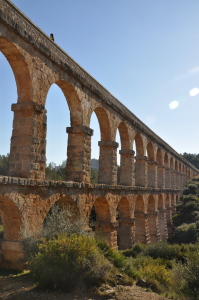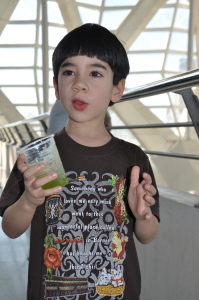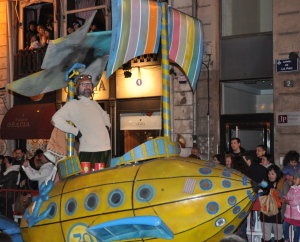Keeping up the theme of the odd, interesting, superstitious and wonderful things about Spain, let me share a few more observations from our lives here so far:
- Festivals and holidays almost seem like the center of the culture here. There literally is a celebration almost every week. For the kids, there is not one, but two school breaks after Christmas. First up is Semana Blanca in February, which is a week off with loose ties to Carnival or snow (hence “blanca” or white), depending on whom you ask. After that comes Semana Santa at the end of March. As opposed to celebrating the pudgy guy in the red suit, this loosely translates to Holy Week or Saints Week, which explains it’s positioning right before Easter. It all adds up to a lot of days off and a lot of eating.
- Learning Spanish continues to astound me. At this point, I am fully convinced that learning another language later in life is just about the hardest thing you can do, mainly because of all the ingrained bad habits developed over years. I think I’m like many people who like to progress based on milestones – e.g. I know I can get to the goal of point A by accomplishing B and C. The challenge with language is the size. Learning a language is so wide that Point A never seems to make it to the near horizon. The good days when something seems to stick are rewarding, but looking at the whole picture is daunting to say the least. And Spanish has a structure and rules that really are light years from English norms.
- Like most big cities, there is a wide range of flats to rent here in Barcelona. You can get a reasonably-sized place right in the heart of the city for as little as 700 or 800 Euros, or spends thousands on a more modern place with extra size. In the US, price is often all about size, but that’s not necessarily true here. There are a lot of older apartments that are quite large but not that expensive, mainly because they have not been updated. Plus, size can be deceiving based on how it’s used. I saw a listing for an apartment that was more than 2000 square feet, so quite large, but it had seven bedrooms, so clearly the rooms were about the size of a closet. Any child older than five probably couldn’t fit in half of them. Finding a place that has been modernized is a challenge and usually comes with a price tag. It adds up to lots of balancing of the wants and needs.
- The biggest soccer (futbol) club in Barcelona is the world famous FC Barcelona. Fans of the team are nicknamed culés, which is the Catalan word for “asses.” The name harks back to the days of the team’s old stadium, which was so small and low that some fans would sit on the edge of it, allowing people walking by to see a row of behinds hanging over during games. Funny what sticks with people. As one of the most famous and successful clubs in the world, FC Barcelona brings in annual revenue in excess of $600 million, but it has actually been badly saddled with debt until new management got a handle on things starting about five years ago. Huge player salaries and transfer fees in the millions were definitely taking a toll. Recent profits have helped drop the debt below $300 million.
- It seems ironic that Barcelona has lots of yellow-vested police wandering the sidestreets writing parking tickets, yet the locals think nothing of parking wherever need be. You gotta pay attention walking down the sidewalk or ending up on somebody’s front bumper or astride a passing motorcycle is completely possible. They take sharing the sidewalk to a new high.
- In many restaurants here, the menu of the day (menu del dia) is quite a value, even though it tends to be more than I typically would want at lunch. It usually consists of a starter, main course, bread, drink and dessert or coffee for around 10 to 12 Euros. There’s no difference in price whether you want water or wine as the drink. Alternatively, opting for the famous Spanish tapas can turn into a pricey option. Two people ordering four or five tapas and a drink can easily be 40 Euros, and not even be that filling. It’s kind of a mismatch that I don’t quite understand.
- Historically, tapas were small dishes that bars would hand out free to those drinking. The norm was a small plate for each drink ordered. That’s quite a neighborly tradition. It’s not very common at this point in Barcelona, but I hear it is still in place in some southern parts of Spain.
- Coming from the US where liquor is the key profit driver in most restaurants, it’s strange to see the opposite here. Beer or wine is the same price as water and might even be less than a Coke. The other day in a supermarket, I spotted a four-pack of wine for 4 Euros (and no, I didn’t buy it). More remarkable is the reality that a 3 Euro bottle of wine is actually pretty good and not the headache-inducing swill that you might expect from the price. I’m at a loss how there’s any profit built into a 4-pack of wine for 4 Euros. And considering a glass of wine or beer at lunch is also the norm here, also at a loss how more of the locals are not lushes.
- I have a new entry into the brand name hall of fame. It’s crowded territory here with honors already going to SMEG for an oven, Candy for a microwave and WASH ME for laundry soap, but I can’t resist adding this entry from Peugeot. I just spotted a Bipper on the street. Who wouldn’t want to own a car called a Bipper?
- Not sure if it’s just an old building legacy thing or not, but I noticed that the toilets here use remarkably large waste pipes, far bigger than North American standards. Maybe not the nicest image as we near dinner time, but I’m pretty sure I could flush a rotisserie chicken down that thing without plugging it up. Put that in the good to know file.
- If anyone asks the core reason why we moved to Spain, the logic that always springs to mind is not solely about Spain. There are few things I enjoy more than being outside, in the city, surrounded by history and interesting sights, and knowing that a different food or cultural experience is just steps away. Really, that’s the center point of all travel for me and the reason I have gone to so many places. Now, I get to have that sensation almost anytime I step out the front door. It makes me feel very fortunate.

 ns including an amphitheater and a circus. But just a couple of miles outside Tarragona is the most impressive site, a Roman aqueduct in a remarkable state of preservation. It spans a valley more than 800 feet wide and is over 85 feet high. It’s a little surreal to be able to walk across something built more than two millennia ago.
ns including an amphitheater and a circus. But just a couple of miles outside Tarragona is the most impressive site, a Roman aqueduct in a remarkable state of preservation. It spans a valley more than 800 feet wide and is over 85 feet high. It’s a little surreal to be able to walk across something built more than two millennia ago. um is very hands-on with interactive displays. Liam sat in on a science workshop and came out proudly displaying the transformation of simple ingredients into a cup of yellow goop. We were thankful at the short memory of a five-year-old that allowed the oozing goop to quietly disappear into a waste can shortly after the workshop.
um is very hands-on with interactive displays. Liam sat in on a science workshop and came out proudly displaying the transformation of simple ingredients into a cup of yellow goop. We were thankful at the short memory of a five-year-old that allowed the oozing goop to quietly disappear into a waste can shortly after the workshop.
 kings experience was pretty tough to top, but we did take time to see a few more of the city’s sites, including the cathedral, plaza of the virgin, the central market and the main square with its impressive fountains and architecture. We sampled a local specialty drink called Horchata made of tigernuts and tasting like almond milk. And the final highlight was stumbling upon a truly local Spanish restaurant for dinner that was both great and a bargain – the perfect combination.
kings experience was pretty tough to top, but we did take time to see a few more of the city’s sites, including the cathedral, plaza of the virgin, the central market and the main square with its impressive fountains and architecture. We sampled a local specialty drink called Horchata made of tigernuts and tasting like almond milk. And the final highlight was stumbling upon a truly local Spanish restaurant for dinner that was both great and a bargain – the perfect combination.